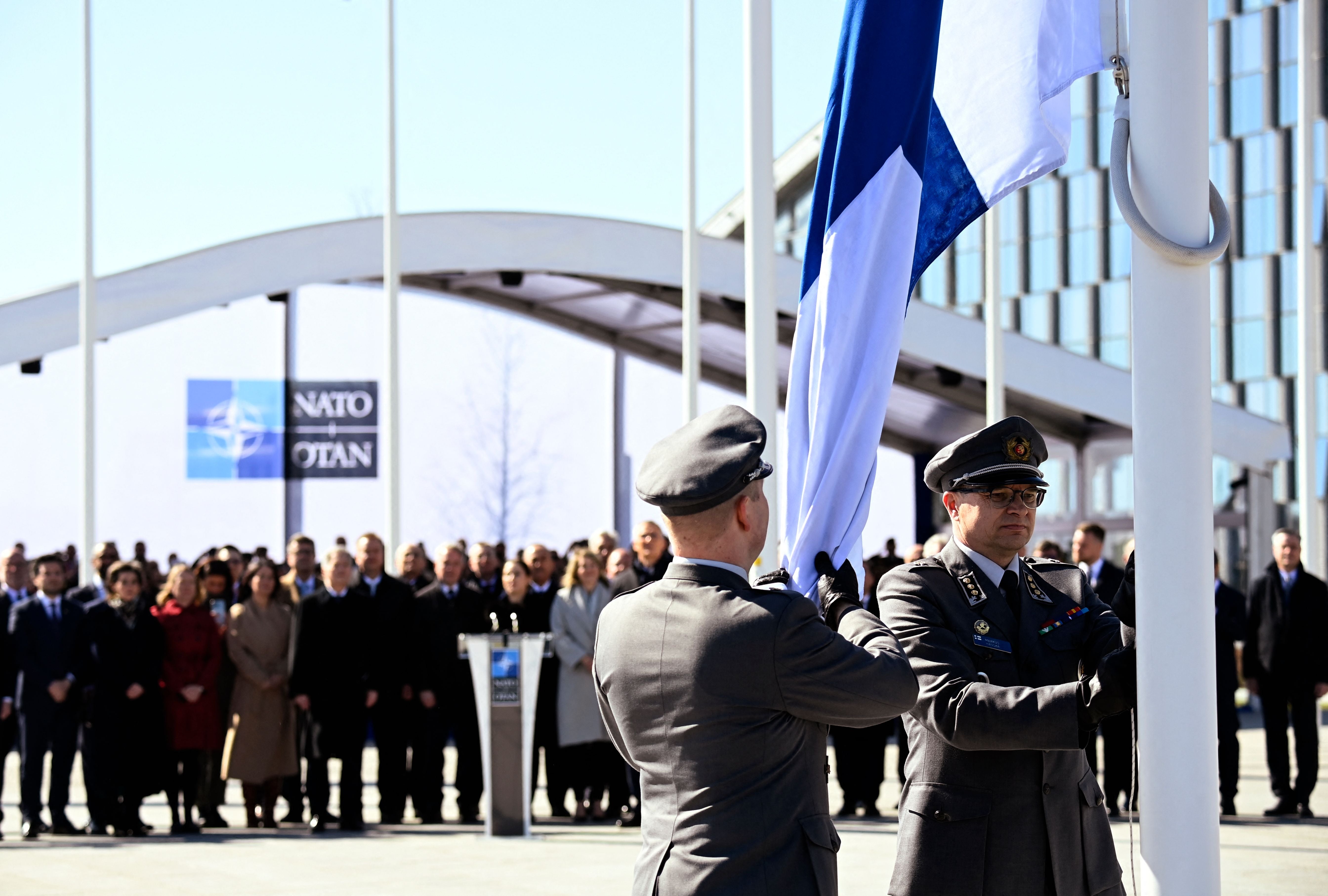What does Finland joining Nato mean for the alliance?
There are plenty of benefits to the move, but there are also some risks, writes Sean O’Grady


Finland has abandoned its traditional, long-standing policy of non-alignment, and is now the 31st member of Nato. It is a significant moment, and one that brings benefits – but also risks – to Finland and the wider West. Finland brings about 250,000 regular and reserve troops, plus strong artillery and expert capabilities in ultra-cold combat conditions.
Why is Finland joining Nato?
The war in Ukraine shifted Finnish public opinion so markedly towards Nato membership as the best way to sustain Finnish independence that it became inevitable. Its application was eagerly supported by almost every other Nato member, with only some resistance from Hungary and Turkey, who’ve been generally more cautious about expansion and support for Ukraine.
It creates a new far longer direct border between Nato and Russia, which cuts both ways in terms of security. Finland now benefits from the “all for one, one for all” mutual assistance pledge in Article 5 of the Nato treaty.
On the other hand, Russia objects to the move as Western expansionism, and has made vague threats about counter-measures. The Kremlin would be even more agitated if nuclear weapons made their way onto Finnish soil (although that does not seem likely at the moment). While a Russian invasion is vanishingly unlikely, the Russians might resort to destabilising air or naval incursions, cyber-attacks or stationing nuclear warheads clause to the border.
Why didn’t it apply for Nato membership before?
For most of the postwar period, Finland wasn’t allowed to. Because the Finns ended up on the wrong side in the Second World War, (though they’d actually been attacked by Stalin in 1939), they had to agree a tough peace treaty with Russia, or the Soviet Union as it was then. Reparations were paid, territory ceded, ethnic Finns were expelled from their homes and Finland was obliged to follow a policy of neutrality.
In 1992, after the fall of the Soviet Union and eastern bloc, a new treaty was concluded that merely committed both sides to non-aggression. It opened the way to membership in the EU in 1995, but Helsinki continued with its previous path of military neutrality. The nation was content with this status of “buffer state”. Indeed, before the invasion last year, the Russians sought the “Finlandisation” of Ukraine, locking it into a permanent stable posture of neutrality (though Finland prudently maintained a substantial and well-equipped military focused on defence, just in case). The great irony now is that president Vladimir Putin’s invasion of Ukraine has “de-Finlandised” Finland, and he has a larger, stronger and more united Nato parked to his west, enthusiastically supporting Ukraine’s resistance.
Does it make Finland and the West safer?
On balance, yes. Although Finland hasn’t been part of the Russian Empire since independence in 1917, it was subject to occasional Russian harassment, including the Winter War of 1939 to 40, and the Russians regarded it as part of its broad sphere of influence – albeit capitalist, Western and well outside the formal Eastern bloc. As with the Baltic Republics, Moldova, Poland, Hungary, Bulgaria and Romania, as well as Ukraine, Putin seems to be nostalgic for the old days of Russian hegemony in the east. As a neutral state, without Nato guarantees, Finland was vulnerable, either to attack or some general bullying.
The Nato bond of mutual assistance should deter any serious Russian onslaught, but using the same arguments applied to Ukraine, Russia would argue that the Finnish move is a menacing “encircling” act of aggression by the West.
What could go wrong?
Though far from the troubled Balkans, the tensions and national rivalries in the northeastern corner of Europe are less obvious but no less intense. So territorial disputes and historical grievances in the deep freeze during the Cold War and after may start to thaw and add to existing frictions. One source of unease, for example, has been the treatment of Russian-speaking minorities in the Baltic states; and access to the Russian exclave of Kaliningrad and its naval base through Polish territory.
Having been occupied, reshaped and abused for much of their history by their powerful eastern neighbour, Finland, Estonia, Latvia, Lithuania and Poland feel more nervous than most about Putin’s revanchist policies. Hence their unusually strong economic and military assistance to Ukraine. Without them, the Western response might well have been more reserved.
Who else is going to join?
Sweden is at the top of the list of prospective members but has been blocked by Turkey (and to a lesser extent Hungary). Ankara accuses Stockholm of supporting Kurdish separatist groups, or “Nordic terrorists” as president Recep Tayyip Erdogan calls them. That hasn’t prevented Sweden from providing bilateral help to Ukraine; and, with sufficient concessions in other policy areas, Erdogan will probably relent, notwithstanding his own more non-aligned stance on the war.
Moldova, sandwiched between Romania, Ukraine and the Russian-supported breakaway state of Transnistria, is a poor, military-weak country that is at extreme risk of unwelcome Russian attention. Especially if Russia ever succeeded in capturing southwest Ukraine. However, such is its precarious position that it has not sought to alter its constitutionally neutral policy. Nato has agreed to a “package of tailored support measures to help Moldova strengthen its national resilience and civil preparedness”.
Away from the east, Ireland has been subject to Russian incursions into its territorial waters, and has condemned the invasion of Ukraine, but there seems no great movement to join Nato. Austria, under the 1955 State Treaty with Russia, is obliged to remain neutral. Ireland, Austria, Sweden, Malta and Cyprus all subscribe to the EU’s Common Security and Defence Policy.






Join our commenting forum
Join thought-provoking conversations, follow other Independent readers and see their replies
Comments